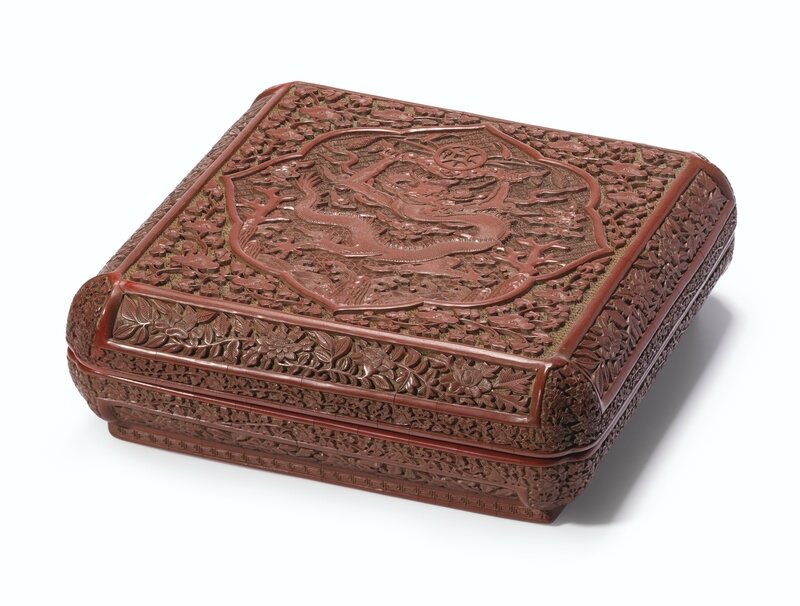A Carved Cinnabar Lacquer Box and Cover, Mark and Period of Wanli, Dated in Accordance with 1595
Lot 46. A Carved Cinnabar Lacquer Box and Cover, Mark and Period of Wanli, Dated in Accordance with 1595: 9.5 by 29.3 by 29.3 cm., 3 3/4 by 11 1/2 by 11 1/2 in. Estimate 1,200,000 — 1,800,000 HKD. Lot sold 2,200,000 HKD. Photo Sotheby's 2014
of square form with slightly bombé sides and cusped corners, all supported on a square foot, deftly carved in varied levels of relief through layers of rich cinnabar lacquer to the ocher ground below, the cover with a barbed panel enclosing a five-clawed dragon (the fifth claw on the hind feet later removed) holding aloft a ribbon of ruyi-shaped clouds supporting a cash medallion flanked by sprays of millet and inscribed with the four characters tianxia taiping (peace under heaven), all above jagged rocks issuing branches of coral against a wavy sea and a sky of floral diapers, the four corners decorated with foliate mallows on a finely carved ochre-yellow diaper-ground, all surrounded around the sides by rectangular panels enclosing a continuous scroll of camellia, chrysanthemum, hibiscus and peony wreathed in their matching foliage and repeated in a reverse sequence around the box, all reserved on a dense floral ground, the foot picked out with key-fret, the interior and the base lacquered in black, the latter dated with an incised eight-character reign mark in gilt.
Provenance: Collection of Frederick Mayer.
Christie’s London, 24th / 25th June 1974, lot 120.
Note: The present finely carved box is closely related to one of the same decoration, and inscribed with the same cyclical date corresponding to 1595, in the collection of the Tokyo National Museum, and included in the museum’s exhibition Toyo no urushi kogei, Tokyo, 1977, cat. no. 545, together with a tray bearing the same dragon design as seen on the cover here, cat. no. 548. Compare also an unmarked red lacquer box of this shape, size and decoration sold in these rooms, 2ndMay 2005, lot 618; and another offered in these rooms, 30thOctober 2000, lot 272.
A rectangular polychrome lacquer box with a similar dragon motif on the cover, dated to 1589, in the National Palace Museum, Taipei, is mentioned by Peter Lam in Layered Beauty, Hong Kong, 2010, p. 126; another, also bearing a cyclical date that corresponds to 1595, was sold at Christie’s Hong Kong, 27th May 2008, lot 1563; and a third rectangular box, in the Palace Museum, Beijing, dated to 1595, is published in Wang Shixiang, Ancient Chinese Lacquerware, Beijing, 1987, pl. 65.
Compare another rectangular box carved in a very similar manner, in the National Museum of Scotland, illustrated in Hu Shih-chang and Jane Wilkinson, Chinese Lacquer, Edinburgh, 1998, pl. 22, where on p. 17, it is mentioned that one claw of the dragon has been removed from each of the hind feet, as seen on the dragon on this box. The removal of a claw was a common practice, as explained by Harry Garner in Chinese Lacquer, London, 1979, p. 92, where he writes that it was either done when the box was presented by the emperor to someone who had merited the honour, but did not have the appropriate ranking to own such an imperial item; or, more often, the claw was removed to disguise the fact than the box may have been stolen or removed illegally from the palace.
Sotheby's. The Baoyizhai Collection of Chinese Lacquer, Part 1, Hong Kong, 08 Apr 2014

/https%3A%2F%2Fprofilepics.canalblog.com%2Fprofilepics%2F1%2F0%2F100183.jpg)
/https%3A%2F%2Fstorage.canalblog.com%2F03%2F02%2F119589%2F96711876_o.jpg)
/https%3A%2F%2Fstorage.canalblog.com%2F11%2F31%2F119589%2F94773502_o.jpg)
/https%3A%2F%2Fstorage.canalblog.com%2F20%2F83%2F119589%2F94772815_o.jpg)
/https%3A%2F%2Fstorage.canalblog.com%2F26%2F72%2F119589%2F75604929_o.jpg)
/https%3A%2F%2Fstorage.canalblog.com%2F59%2F60%2F119589%2F26458628_o.jpg)





/image%2F1371349%2F20240411%2Fob_a3392b_2024-nyr-22642-0917-000-a-qingbai-foli.jpg)
/http%3A%2F%2Fstorage.canalblog.com%2F16%2F06%2F119589%2F129705144_o.jpg)
/http%3A%2F%2Fstorage.canalblog.com%2F86%2F19%2F119589%2F129426368_o.jpg)
/http%3A%2F%2Fstorage.canalblog.com%2F80%2F72%2F119589%2F129345826_o.jpg)